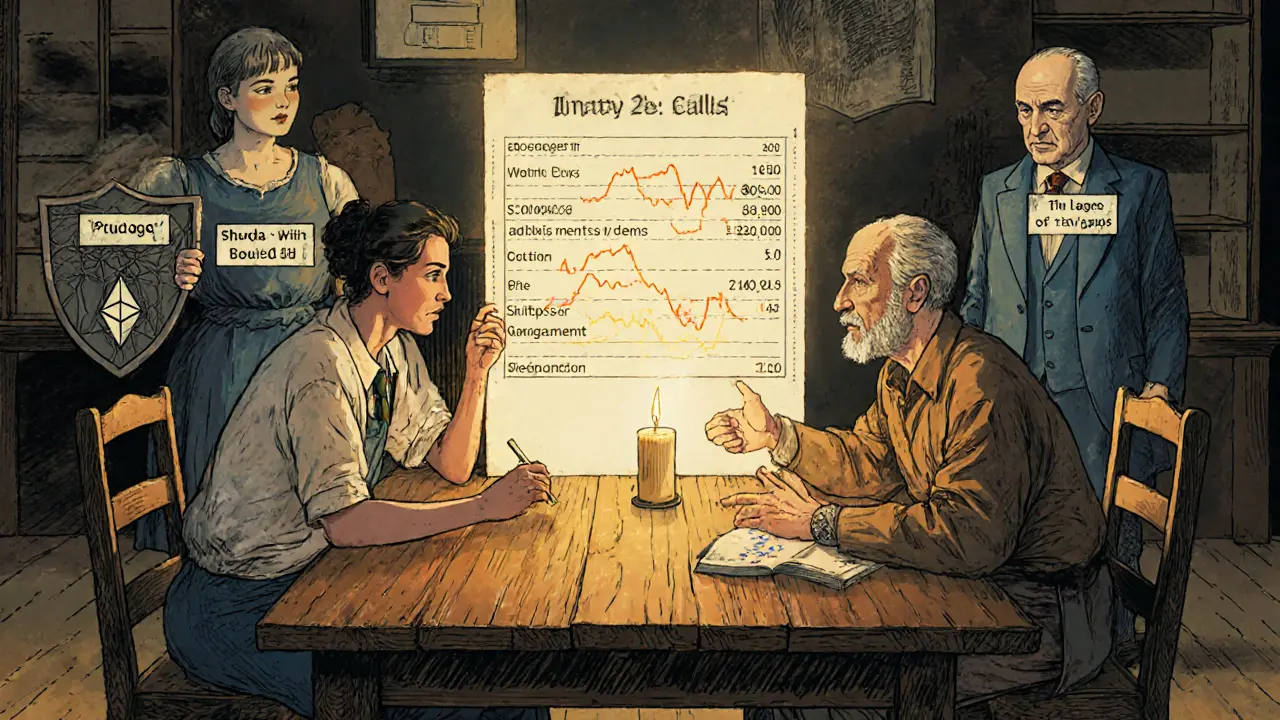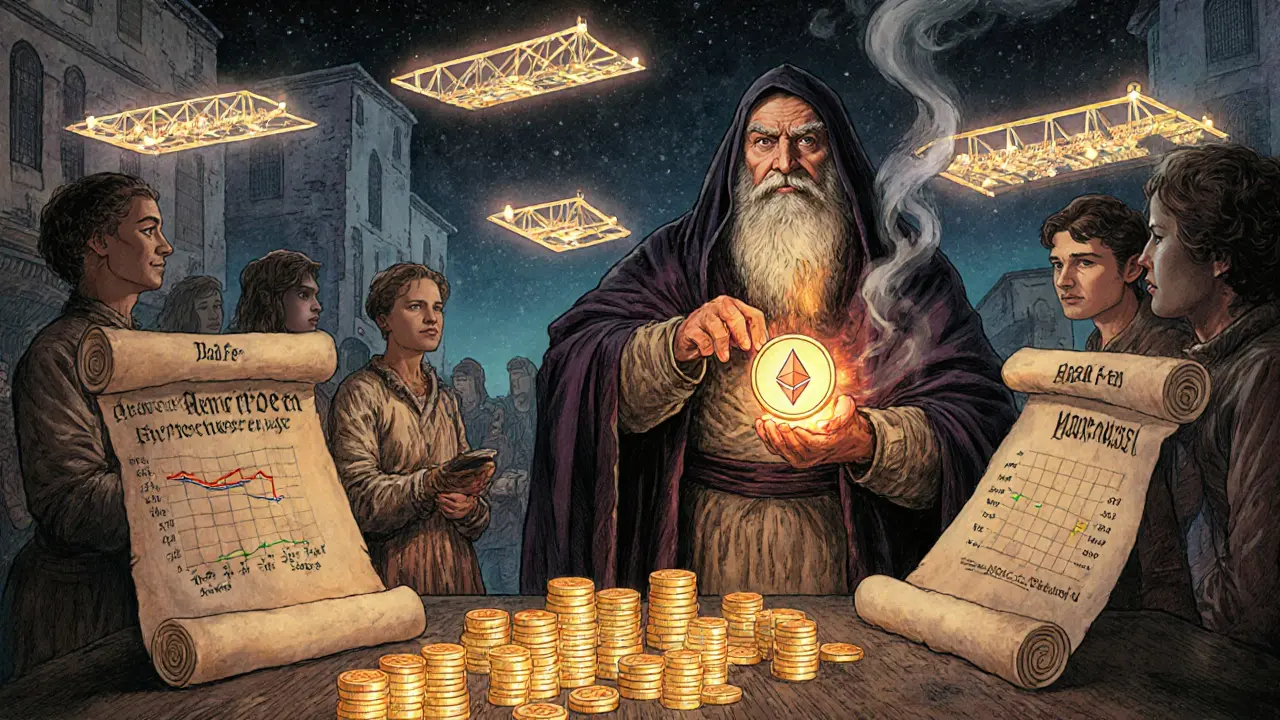Ethereum Gas Fee Calculator
Calculate Your Transaction Cost
Base Fee: 2.7 gwei Priority Fee: 0.2 gwei Total: 2.9 gwei
Five years ago, sending a simple ETH transfer could cost you $20. Trading an NFT? That might’ve run you $150. Today, the same actions cost less than a cup of coffee. The Ethereum network didn’t just get cheaper-it got Ethereum gas fees transformed. Thanks to the Dencun upgrade in early 2025, gas fees dropped by 95%. What used to be a barrier for everyday users is now a non-issue for most transactions.
How Ethereum Gas Fees Work Now
Ethereum gas fees aren’t random charges. They’re payments to validators who process your transactions. Since the EIP-1559 update in 2021, the system became smarter. Now, your fee has two parts: the base fee and the priority fee.The base fee is automatic and burns-meaning it disappears from circulation. It goes up when the network is busy and drops when it’s quiet. The priority fee is your tip to validators if you want your transaction to go faster. You can set it to zero if you’re not in a rush.
Here’s the math: total fee = (base fee + priority fee) × gas limit. A basic ETH transfer uses 21,000 gas units. With the current average gas price at 2.7 gwei (down from 72 gwei in 2024), that’s just 56,700 gwei-or $0.08. Even complex DeFi swaps now average $0.39, compared to $86 in 2023.
How Ethereum Compares to Other Blockchains
Ethereum isn’t the only game in town. But in 2025, it’s no longer the expensive outlier.Solana still holds the crown for raw speed and low cost. A typical Solana transaction costs around $0.00025. That’s cheaper than Ethereum’s base fee. But Solana has had outages. In 2024 alone, it went down five times due to network overload. Ethereum, even under stress, stays up. Its security and decentralization aren’t traded for speed.
Then there’s Polygon, Arbitrum, and Optimism-Layer 2 solutions built on top of Ethereum. They’re not competitors. They’re force multipliers. These networks process transactions off-chain, then batch them back to Ethereum. The result? Fees drop 90-99%. On Arbitrum, a token swap costs $0.01. On Optimism, it’s $0.02. And you still get Ethereum’s security.
Cardano and Avalanche also offer low fees, but they lack Ethereum’s ecosystem. You won’t find the same depth of DeFi apps, NFT marketplaces, or developer tools. Ethereum’s network effect is unmatched. Even with higher fees in the past, it held 70% of all blockchain activity. Now, with fees this low, that dominance is growing.

When Fees Spike-And How to Avoid Them
Don’t get fooled. Ethereum’s fees aren’t always cheap. During big NFT drops or major DeFi launches, congestion spikes. On February 19, 2025, one swap cost $50. That’s not normal-but it happens.The fix? Time your transactions. Weekends, especially Sunday evenings UTC, are the quietest. Early mornings (4-7 AM UTC) are also low-traffic. Avoid peak hours: 12-3 PM UTC on weekdays, when U.S. traders are active.
Use tools like EthGasStation or MetaMask’s built-in gas tracker. They show real-time base fees and suggest optimal priority fees. Most wallets now let you adjust fees before confirming. You can even schedule transactions for later when fees drop.
Pro tip: Don’t set your gas limit too high. If you’re sending ETH, 21,000 is enough. For DeFi swaps, 250,000-500,000 is typical. Excess gas doesn’t mean faster-it just means wasted money.
Layer 2s Are the Real Winner
The biggest shift in 2025 isn’t just lower Ethereum fees-it’s the rise of Layer 2s. Over 60% of all Ethereum activity now happens on Arbitrum, Optimism, or Polygon. That’s up from 30% in 2023.Why? Because Layer 2s combine Ethereum’s security with near-zero fees. You can swap tokens, stake, lend, or buy NFTs for pennies. And when you want to move funds back to Ethereum mainnet, it’s still cheaper than ever.
Wallets like MetaMask and Coinbase Wallet now auto-detect Layer 2 networks. You don’t need to switch accounts. Just click “Switch Network” and you’re on Arbitrum with $0.03 fees.
Even big brands are moving. Coinbase, Uniswap, and Aave all now default to Layer 2 for most users. The future isn’t choosing between Ethereum and another chain-it’s using Ethereum through its cheaper, faster cousins.

What This Means for You
If you’re still avoiding Ethereum because of fees, you’re missing out. The network is now usable for small transactions: tipping creators, buying digital art, swapping stablecoins, even paying for apps with crypto.For developers, lower fees mean more users. Apps that were too expensive to run on-chain now make sense. For investors, it means more DeFi yield opportunities without the fee tax.
And for regular users? You can finally treat crypto like money-not a luxury experiment. Sending $5 to a friend? Done. Buying a $20 NFT? Easy. Trading $100 in ETH for USDC? No sweat.
The era of Ethereum being too expensive for daily use is over. The Dencun upgrade didn’t just tweak the system-it reset the entire value proposition.
What’s Next for Ethereum Fees?
The Ethereum Foundation has more upgrades planned. Proto-danksharding, coming in late 2025 or early 2026, will add even more data capacity. That means even lower fees and higher throughput.Meanwhile, Layer 2s are getting smarter. New rollups are launching with faster finality and cheaper gas. Some are even experimenting with fee subsidies-where apps pay your gas for you.
Don’t expect fees to hit zero. That’s not the goal. Ethereum wants to be secure and decentralized. The aim is to make fees low enough that they’re irrelevant-like paying $0.01 to send an email.
Right now, that’s already true for most people. If you’re still scared of gas fees, it’s time to try again. The system works now. And it’s never been this easy.
Why did Ethereum gas fees drop so much in 2025?
The Dencun upgrade introduced major improvements to how Ethereum handles data. It added a new way to store transaction data more efficiently, reducing congestion on the main chain. This allowed Layer 2 networks to process more transactions at lower cost, which in turn lowered pressure on Ethereum’s base layer. The result was a 95% drop in average gas fees-from $86 per swap to under $0.40.
Is Solana cheaper than Ethereum now?
Yes, Solana still has lower base fees-around $0.00025 per transaction. But Ethereum’s fees are now competitive for most use cases, especially when you use Layer 2s like Arbitrum or Optimism. Solana has had reliability issues, with multiple outages in 2024. Ethereum, even during spikes, stays online. For most users, the trade-off isn’t just cost-it’s trust.
Do I need to use a Layer 2 to save money on Ethereum?
Not always. Simple ETH transfers or stablecoin swaps now cost under $0.10 on mainnet. But if you’re doing DeFi, NFTs, or frequent trades, Layer 2s are essential. On Arbitrum or Optimism, you’ll pay 90-99% less. Most wallets now auto-switch to Layer 2s when it makes sense. You don’t need to be technical.
How do I check real-time gas fees?
Use MetaMask’s built-in fee estimator, or visit sites like EthGasStation or Blockchair. These show current base fees, recommended priority fees, and historical trends. You can also set alerts to notify you when fees drop below a certain level.
Can I avoid paying gas fees entirely?
Not on Ethereum. Every transaction needs gas. But some apps offer “gasless” transactions where the app pays the fee for you-like when you sign up for a new DeFi protocol. These are exceptions, not the norm. For regular use, low fees are the goal, not zero fees.
Are Ethereum gas fees taxable?
In most countries, gas fees themselves aren’t taxed. But if you’re trading crypto and paying gas, the fee is part of your cost basis. For example, if you buy ETH for $2,000 and pay $0.50 in gas, your cost basis becomes $2,000.50. When you sell, that affects your capital gains. Always consult a tax professional familiar with crypto.

Bhavna Suri
November 1, 2025 AT 22:51This is all nice and fancy, but who actually uses this? I tried to send 0.1 ETH last week and still got hit with $1.50. Something’s off.
Not buying the 95% drop claim. Looks like marketing fluff to me.
Elizabeth Melendez
November 2, 2025 AT 03:53OMG YES I’M SO GLAD THIS IS FINALLY HAPPENING!! I used to avoid Ethereum like it was a tax audit, but now I’m swapping tokens on Arbitrum like it’s nothing. I sent $3 to my cousin for coffee last Tuesday and it cost less than my coffee. Like, literally. I cried. Not kidding. I’ve been waiting for this since 2021. Layer 2s are the real MVPs here-no cap. MetaMask just auto-switches now and it feels like magic. We’re living in the future and I didn’t even have to upgrade my phone.
Also, if you’re still on mainnet for swaps? Honey, you’re doing it wrong. Go to Optimism. You’ll thank me later. 🙏
Phil Higgins
November 4, 2025 AT 03:29The real breakthrough isn’t the fee drop-it’s the philosophical shift. Ethereum has always been about trust, not speed. Solana offers cheapness at the cost of reliability. Ethereum offers stability at the cost of... well, nothing anymore. The Dencun upgrade didn’t just optimize gas-it redefined what decentralization means in practice. We’re no longer choosing between security and usability. We’ve merged them.
Layer 2s aren’t a workaround. They’re an evolution. And the fact that users don’t even notice the switch? That’s the quietest revolution in tech history. No fanfare. No press releases. Just people transacting like money was meant to be used.
Genevieve Rachal
November 5, 2025 AT 04:35LMAO. "Less than a cup of coffee"? You’re telling me $0.08 is "cheap"? Try living in a city where coffee costs $8 and then tell me that’s "non-issue".
Also, "Ethereum’s security"? Please. You think the network is secure because it’s decentralized? What about the 2024 MEV exploits? The front-running bots? The whales who front-run your NFT drops? You’re not paying for gas-you’re paying for privilege.
And don’t get me started on Layer 2s. They’re centralized proxies with fake security. Arbitrum’s sequencer is owned by Offchain Labs. That’s not decentralization-that’s corporate outsourcing. You’re being sold a lie.
Eli PINEDA
November 5, 2025 AT 19:04wait so if i send eth on arbitrum its like 0.01$ but if i send to mainnet its 0.08$?? so why would i evr use mainnet??
also does that mean my nft is still "on ethereum" if its on arbitrum?? i feel confused lol
Debby Ananda
November 7, 2025 AT 01:51Wow. Just wow. 😍 I’m not even mad anymore. I used to cry when I saw my gas fees. Now I just laugh. I bought an NFT for $20 and paid $0.02 in gas. I felt like a billionaire. 🌟
Also, I just switched to Optimism and my wallet auto-did it. I didn’t even know how. I think I’m becoming a crypto god. ✨
Vicki Fletcher
November 8, 2025 AT 03:56Okay, I’m not a dev, but I’ve been reading this for 20 minutes, and I think I get it.
Base fee burns? So it’s like… the network eats the money? That’s wild. And priority fee is just a tip? So if I’m chill, I can set it to zero? I’m trying this tomorrow.
Also, why do people say "gas limit" like it’s a race? I just want to send $5 to my cousin. 21,000? Got it.
And… Layer 2s? Are they like… subways to Ethereum? I think I’m starting to understand. Maybe.
Thanks for not talking over me. I actually learned something today. 😊
Nadiya Edwards
November 10, 2025 AT 02:15They’re not making fees cheaper-they’re making you forget how much you’re paying.
Remember when you used to pay $150 for an NFT? Now you pay $0.40. But what did you really pay? Your data. Your attention. Your trust.
They want you to think this is freedom. It’s not. It’s conditioning.
Every time you click "switch to Arbitrum," you’re giving up sovereignty.
They’ll tell you it’s secure. But who controls the sequencer? Who audits the code? Who answers when it breaks?
They’re not lowering fees. They’re lowering your standards.
Ron Cassel
November 11, 2025 AT 03:0295% drop? Yeah right. That’s the official number. The real truth? The Fed’s printing more dollars, so everything looks cheaper. Gas fees didn’t drop. The dollar did.
And Layer 2s? They’re all controlled by the same VC firms that run Coinbase and Binance. You think you’re decentralized? You’re just using a branded Walmart with a blockchain sticker.
And don’t get me started on Dencun. That’s just the first step. Soon they’ll make you pay in ETH for access to your own wallet. You think this is progress? It’s a trap.
ISAH Isah
November 12, 2025 AT 08:16It is true that fees have decreased significantly
However one must consider the broader context
Is the network truly more decentralized or merely more complex
Layer two solutions introduce new points of failure
And the illusion of low cost may lead to overuse
Which in turn may create new congestion
One must think beyond the immediate benefit
And consider the long term sustainability
Not all that glitters is blockchain
And not all that is cheap is free
Chris Strife
November 13, 2025 AT 17:53USA built this. USA secured this. USA made the code.
Now you’re telling me India and Nigeria are using it to send $0.01 payments?
Pathetic. We gave them the tools. Now they think it’s theirs.
Gas fees are low? Good. That means more Americans can use it.
Not the rest of the world. Not the freeloaders.
This is American tech. Don’t let them forget it.
Mehak Sharma
November 15, 2025 AT 13:15Let me tell you something-this isn’t just about fees. This is about liberation.
Before, crypto was a luxury for the rich, the tech-savvy, the risk-takers.
Now? A grandmother in Delhi can tip her grandson for sending her a meme. A street vendor in Lagos can receive payment without a bank. A student in Manila can buy a digital collectible without needing a credit card.
Ethereum didn’t just lower gas-it lowered barriers.
It turned a playground for hedge funds into a public square.
And Layer 2s? They’re not just scaling-they’re democratizing.
This is the internet’s next chapter. Not Web3. Not metaverse. Just… people. Using money. Like it was meant to be used.
And if you’re still scared? That’s okay.
But don’t stand in the way of those who are ready to walk through.
Matthew Affrunti
November 16, 2025 AT 14:51Just tried sending ETH to my buddy and paid $0.06. I was ready to brace for $5. I literally sat there staring at the screen like ‘did it actually work?’
And the wallet switched to Arbitrum automatically? That’s insane. I didn’t even know I had to do anything.
Feels like the crypto world finally grew up.
Still don’t get all the Layer 2 jargon but I don’t need to. It just works now.
Thanks for writing this. Made me feel less like a noob.
mark Hayes
November 17, 2025 AT 14:26Been holding ETH since 2021. Thought I’d never use it for anything but HODLing.
Now I’m swapping USDC for DAI on Optimism like it’s a vending machine.
Zero stress. Zero drama. Just… done.
Feels good to finally be on the right side of history.
Also, I’m not even techy. I just tap and go.
That’s the real win.
🥹
Derek Hardman
November 19, 2025 AT 10:23The elegance of this transformation lies not in its technical brilliance alone, but in its quiet normalization.
Once, Ethereum gas fees were a topic of heated debate, a barrier to entry, a symbol of exclusion.
Now, they are unremarkable. Forgotten. Irrelevant.
That is the hallmark of true innovation-not when it dazzles, but when it disappears into the fabric of daily life.
Layer 2s are not a workaround. They are the natural evolution of a network that prioritized security above all else-and then, through patient engineering, made that security accessible.
This is not merely a fee reduction. It is a quiet revolution in user dignity.
Elizabeth Melendez
November 20, 2025 AT 01:32^^^ this is exactly why I love this community. You said it better than I could.
It’s not about the numbers. It’s about the silence. No more screaming about fees. No more panic selling because a swap costs $30.
Just… transactions. Like email. Like water. Like electricity.
That’s the real win.